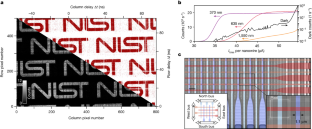2023-10-25 米国国立標準技術研究所(NIST)
◆このカメラは、超伝導ナノワイヤーグリッドで構成され、非常に低温で冷却された状態で動作します。光子が特定の場所(ピクセル)に当たると、超伝導性が遮断され、その場所の位置と強度を組み合わせて画像を生成します。
◆この技術は、微かな銀河や惑星の画像取得、光子ベースの量子コンピュータでの光の測定、および近赤外光を使用して人間の組織にのぞき見る生物医学研究など、低光の研究に応用される見通しです。将来的には、さらに多くのピクセルを備えた超伝導単一光子カメラが利用可能になるかもしれません。
<関連情報>
- https://www.nist.gov/news-events/news/2023/10/nist-team-develops-highest-resolution-single-photon-superconducting-camera
- https://www.nature.com/articles/s41586-023-06550-2
40万画素の超伝導ナノワイヤー単一光子カメラ A superconducting nanowire single-photon camera with 400,000 pixels
B. G. Oripov,D. S. Rampini,J. Allmaras,M. D. Shaw,S. W. Nam,B. Korzh &A. N. McCaughan
Nature Published:25 October 2023
DOI:https://doi.org/10.1038/s41586-023-06550-2

Abstract
For the past 50 years, superconducting detectors have offered exceptional sensitivity and speed for detecting faint electromagnetic signals in a wide range of applications. These detectors operate at very low temperatures and generate a minimum of excess noise, making them ideal for testing the non-local nature of reality1,2, investigating dark matter3,4, mapping the early universe5,6,7 and performing quantum computation8,9,10 and communication11,12,13,14. Despite their appealing properties, however, there are at present no large-scale superconducting cameras—even the largest demonstrations have never exceeded 20,000 pixels15. This is especially true for superconducting nanowire single-photon detectors (SNSPDs)16,17,18. These detectors have been demonstrated with system detection efficiencies of 98.0% (ref. 19), sub-3-ps timing jitter20, sensitivity from the ultraviolet21 to the mid-infrared22 and microhertz dark-count rates3, but have never achieved an array size larger than a kilopixel23,24. Here we report on the development of a 400,000-pixel SNSPD camera, a factor of 400 improvement over the state of the art. The array spanned an area of 4 × 2.5 mm with 5 × 5-μm resolution, reached unity quantum efficiency at wavelengths of 370 nm and 635 nm, counted at a rate of 1.1 × 105 counts per second (cps) and had a dark-count rate of 1.0 × 10−4 cps per detector (corresponding to 0.13 cps over the whole array). The imaging area contains no ancillary circuitry and the architecture is scalable well beyond the present demonstration, paving the way for large-format superconducting cameras with near-unity detection efficiencies across a wide range of the electromagnetic spectrum.



